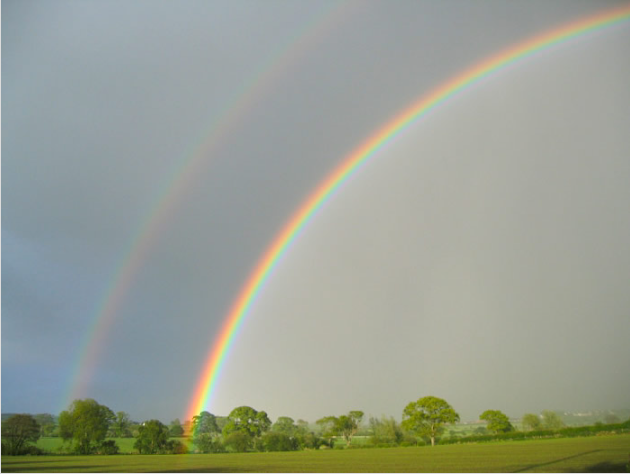Evening rainbow
The Enchanting Phenomenon of Evening Rainbows
Rainbows are one of nature's most captivating displays of color and light. Most commonly associated with rain showers and sunlight, rainbows can also occur during the evening hours, creating a magical spectacle in the sky. Evening rainbows, also known as sunset rainbows or twilight rainbows, offer a unique and mesmerizing experience for those fortunate enough to witness them.
The Science Behind Evening Rainbows
Rainbows are formed when sunlight is refracted, or bent, as it passes through water droplets in the air. This refraction causes the different colors of light to separate and form a circular arc of vibrant hues. In the case of evening rainbows, the low angle of the setting sun creates a stunning effect, casting the bows high into the sky.
The Uniqueness of Evening Rainbows
Evening rainbows possess certain characteristics that set them apart from their daytime counterparts. Here are some key aspects that make evening rainbows a fascinating phenomenon:
-
Color Order Reversal: One distinctive feature of evening rainbows is the reversal of the color order in the secondary bow. While the primary bow follows the typical color sequence of red on the outer edge and violet on the inner edge, the secondary bow showcases a reversed color order.
-
Extended Bows: Due to the low angle of the sun during the evening, rainbows can appear larger and more expansive than those seen during the day. The elongated shape and elevated position of evening rainbows create a breathtaking sight.
-
Enhanced Color Intensity: The warm, golden light of the setting sun enhances the colors of an evening rainbow, intensifying their brilliance and creating a vivid display that is truly awe-inspiring.
The Conditions for Evening Rainbows
To witness an evening rainbow, specific atmospheric conditions must align harmoniously. Here are the essential requirements for the formation of this enchanting phenomenon:
-
Rain or Showers: Evening rainbows, like their daytime counterparts, require rain or showers to provide the necessary water droplets in the air. These droplets act as tiny prisms, refracting and dispersing sunlight to form the rainbow.
-
Clear View of the Horizon: An unobstructed view of the horizon is crucial for observing evening rainbows. The low angle of the sun means that the rainbow will be positioned higher in the sky, making it essential to have a clear line of sight without any tall structures or mountains blocking the view.
-
Direction of Sunlight: Evening rainbows can only occur when the sun is low on the horizon, typically during the early evening hours. The angle of the sunlight must be low enough to allow for the refraction and dispersion of light through the water droplets.
Tips for Spotting Evening Rainbows
If you're hoping to catch a glimpse of an evening rainbow, here are some tips to increase your chances:
-
Timing: Evening rainbows are most likely to occur during the spring and summer months when the weather is more conducive to rain showers. Additionally, they are more common in regions with a higher latitude.
-
Weather Conditions: Keep an eye on the weather forecast. Rain showers or passing storms increase the likelihood of evening rainbows. After a rain shower, wait for the skies to clear, and keep an eye on the western horizon as the sun begins to set.
-
Find an Open Space: To ensure an unobstructed view of the horizon, find an open space away from tall buildings or mountains. A beach or a field can provide an ideal vantage point for spotting evening rainbows.
Capturing the Magic of Evening Rainbows
Photographing evening rainbows can be a rewarding experience, allowing you to capture the enchanting beauty of this atmospheric phenomenon. Here are some tips to help you capture the magic:
-
Use a Polarizing Filter: A polarizing filter can help reduce glare and enhance the colors of the rainbow, making your photographs more vibrant and captivating.
-
Compose Your Shot: Consider the composition of your photograph. Including interesting foreground elements, such as trees or buildings, can add depth and perspective to your image, enhancing the overall visual impact.
-
Experiment with Angles: Don't be afraid to explore different angles and perspectives. Changing your vantage point can provide unique compositions and allow you to capture the full arc of the rainbow.
Evening rainbows are a testament to the beauty and wonder of our natural world. The combination of rain showers, sunlight, and atmospheric conditions creates a stunning display of color and light that leaves us in awe. So, keep your eyes to the sky, and you may be fortunate enough to witness the enchantment of an evening rainbow.

Early evening rainbows Cumbria, England by Anita Evans 24th May '03. The bright inner bow is the primary. The outer secondary bow has its colour order reversed. The low sun has cast the bows high into the sky. ©2003 Anita Evans, reproduced with permission
Note: this article has been automatically converted from the old site and may not appear as intended. You can find the original article here.
Reference Atmospheric Optics
If you use any of the definitions, information, or data presented on Atmospheric Optics, please copy the link or reference below to properly credit us as the reference source. Thank you!
-
<a href="https://atoptics.co.uk/blog/evening-rainbow/">Evening rainbow</a>
-
"Evening rainbow". Atmospheric Optics. Accessed on April 25, 2024. https://atoptics.co.uk/blog/evening-rainbow/.
-
"Evening rainbow". Atmospheric Optics, https://atoptics.co.uk/blog/evening-rainbow/. Accessed 25 April, 2024
-
Evening rainbow. Atmospheric Optics. Retrieved from https://atoptics.co.uk/blog/evening-rainbow/.